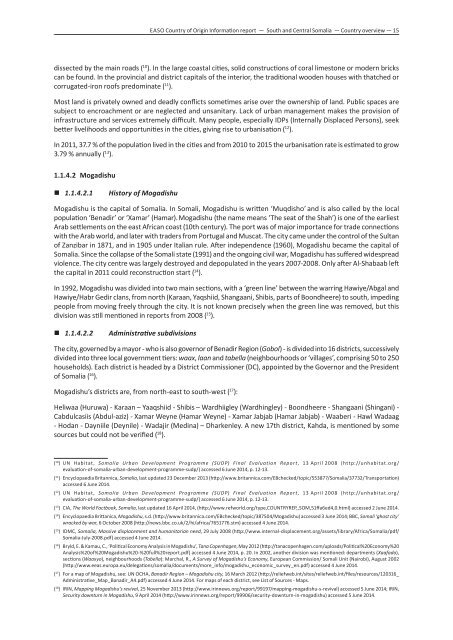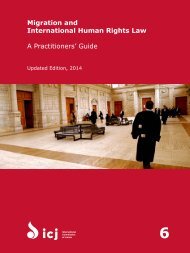Create successful ePaper yourself
Turn your PDF publications into a flip-book with our unique Google optimized e-Paper software.
EASO Country of Origin Information report — South and Central <strong>Somalia</strong> — Country overview — 15<br />
dissected by the main roads ( 10 ). In the large coastal cities, solid constructions of coral limestone or modern bricks<br />
can be found. In the provincial and district capitals of the interior, the traditional wooden houses with thatched or<br />
corrugated‐iron roofs predominate ( 11 ).<br />
Most land is privately owned and deadly conflicts sometimes arise over the ownership of land. Public spaces are<br />
subject to encroachment or are neglected and unsanitary. Lack of urban management makes the provision of<br />
infrastructure and services extremely difficult. Many people, especially IDPs (Internally Displaced Persons), seek<br />
better livelihoods and opportunities in the cities, giving rise to urbanisation ( 12 ).<br />
In 2011, 37.7 % of the population lived in the cities and from 2010 to 2015 the urbanisation rate is estimated to grow<br />
3.79 % annually ( 13 ).<br />
1.1.4.2 Mogadishu<br />
• 1.1.4.2.1<br />
History of Mogadishu<br />
Mogadishu is the capital of <strong>Somalia</strong>. In Somali, Mogadishu is written ‘Muqdisho’ and is also called by the local<br />
population ‘Benadir’ or ‘Xamar’ (Hamar). Mogadishu (the name means ‘The seat of the Shah’) is one of the earliest<br />
Arab settlements on the east African coast (10th century). The port was of major importance for trade connections<br />
with the Arab world, and later with traders from Portugal and Muscat. The city came under the control of the Sultan<br />
of Zanzibar in 1871, and in 1905 under Italian rule. After independence (1960), Mogadishu became the capital of<br />
<strong>Somalia</strong>. Since the collapse of the Somali state (1991) and the ongoing civil war, Mogadishu has suffered widespread<br />
violence. The city centre was largely destroyed and depopulated in the years 2007-2008. Only after Al‐Shabaab left<br />
the capital in 2011 could reconstruction start ( 14 ).<br />
In 1992, Mogadishu was divided into two main sections, with a ‘green line’ between the warring Hawiye/Abgal and<br />
Hawiye/Habr Gedir clans, from north (Karaan, Yaqshiid, Shangaani, Shibis, parts of Boondheere) to south, impeding<br />
people from moving freely through the city. It is not known precisely when the green line was removed, but this<br />
division was still mentioned in reports from 2008 ( 15 ).<br />
• 1.1.4.2.2<br />
Administrative subdivisions<br />
The city, governed by a mayor - who is also governor of Benadir Region (Gobol) - is divided into 16 districts, successively<br />
divided into three local government tiers: waax, laan and tabella (neighbourhoods or ‘villages’, comprising 50 to 250<br />
households). Each district is headed by a District Commissioner (DC), appointed by the Governor and the President<br />
of <strong>Somalia</strong> ( 16 ).<br />
Mogadishu’s districts are, from north‐east to south‐west ( 17 ):<br />
Heliwaa (Huruwa) - Karaan – Yaaqshiid - Shibis – Wardhiigley (Wardhingley) - Boondheere - Shangaani (Shingani) -<br />
Cabdulcasiis (Abdul‐aziz) - Xamar Weyne (Hamar Weyne) - Xamar Jabjab (Hamar Jabjab) - Waaberi - Hawl Wadaag<br />
- Hodan - Dayniile (Deynile) - Wadajir (Medina) – Dharkenley. A new 17th district, Kahda, is mentioned by some<br />
sources but could not be verified ( 18 ).<br />
( 10 ) UN Habitat, <strong>Somalia</strong> Urban Development Programme (SUDP) Final Evaluation <strong>Report</strong>, 13 April 2008 (http://unhabitat.org/<br />
evaluation‐of‐somalia‐urban‐development‐programme‐sudp/) accessed 6 June 2014, p. 12-13.<br />
( 11 ) Encyclopaedia Britannica, <strong>Somalia</strong>, last updated 23 December 2013 (http://www.britannica.com/EBchecked/topic/553877/<strong>Somalia</strong>/37732/Transportation)<br />
accessed 6 June 2014.<br />
( 12 ) UN Habitat, <strong>Somalia</strong> Urban Development Programme (SUDP) Final Evaluation <strong>Report</strong>, 13 April 2008 (http://unhabitat.org/<br />
evaluation‐of‐somalia‐urban‐development‐programme‐sudp/) accessed 6 June 2014, p. 12-13.<br />
( 13 ) CIA, The World Factbook, <strong>Somalia</strong>, last updated 16 April 2014, (http://www.refworld.org/type,COUNTRYREP,,SOM,51ffa6ed4,0.html) accessed 2 June 2014.<br />
( 14 ) Encyclopaedia Brittanica, Mogadishu, s.d. (http://www.britannica.com/EBchecked/topic/387504/Mogadishu) accessed 3 June 2014; BBC, Somali ‘ghost city’<br />
wracked by war, 6 October 2008 (http://news.bbc.co.uk/2/hi/africa/7651776.stm) accessed 4 June 2014.<br />
( 15 ) IDMC, <strong>Somalia</strong>, Massive displacement and humanitarian need, 29 July 2008 (http://www.internal‐displacement.org/assets/library/Africa/<strong>Somalia</strong>/pdf/<br />
<strong>Somalia</strong>‐July-2008.pdf) accessed 4 June 2014.<br />
( 16 ) Bryld, E. & Kamau, C., ‘Political Economy Analysis in Mogadishu’, Tana Copenhagen, May 2012 (http://tanacopenhagen.com/uploads/Political%20Economy%20<br />
Analysis%20of%20Mogadishu%20-%20full%20report.pdf) accessed 4 June 2014, p. 20. In 2002, another division was mentioned: departments (Xaafado),<br />
sections (Waaxyo), neighbourhoods (Tabella): Marchal, R., A Survey of Mogadishu’s Economy, European Commission/ Somali Unit (Nairobi), August 2002<br />
(http://www.eeas.europa.eu/delegations/somalia/documents/more_info/mogadishu_economic_survey_en.pdf) accessed 4 June 2014.<br />
( 17 ) For a map of Mogadishu, see: UN OCHA, Banadir Region – Mogadishu city, 16 March 2012 (http://reliefweb.int/sites/reliefweb.int/files/resources/120316_<br />
Administrative_Map_Banadir_A4.pdf) accessed 4 June 2014. For maps of each district, see List of Sources - Maps.<br />
( 18 ) IRIN, Mapping Mogadishu’s revival, 25 November 2013 (http://www.irinnews.org/report/99197/mapping‐mogadishu‐s‐revival) accessed 5 June 2014; IRIN,<br />
Security downturn in Mogadishu, 9 April 2014 (http://www.irinnews.org/report/99906/security‐downturn‐in‐mogadishu) accessed 5 June 2014.



